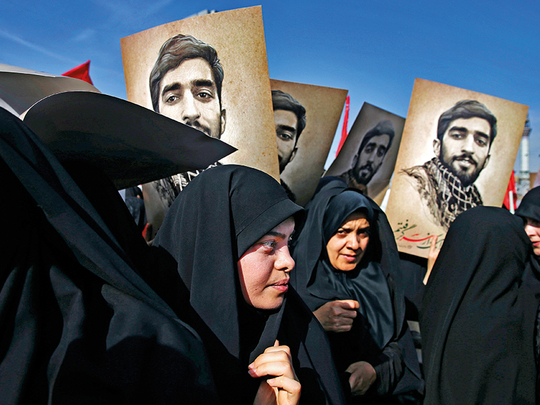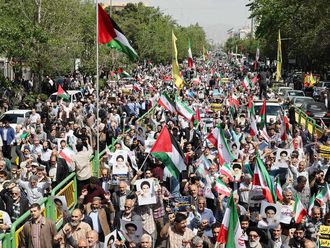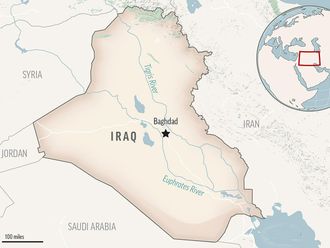
BEIRUT: In demonstrations across Iran, chants are going up against the military’s vast and shadowy war in Syria, one of Tehran’s closest allies and a front-line state in its confrontation with its arch-enemy, Israel.
Although the protests have focused on economic issues, demonstrators have also voiced opposition to the government’s policy of sending young Iranians to fight and die in Syria and spending billions of dollars on the military when they say the priority should be working to provide jobs in Iran and control the rising cost of living.
Their slogans include, “Leave Syria, think about us!” and “Death to Hezbollah!” the Iranian-backed Lebanese militant group that has been a key instrument of Tehran in Syria’s war.
Syria saw its own anti-regime protests in 2011. They were met with a brutal crackdown by Bashar Al Assad’s security services, sending the country into civil war.
But as cracks appeared in Al Assad’s military, with soldiers refusing to fire on protesters and defecting to the opposition, Iran and later Russia stepped in to support their ally.
Iran’s theocratic leadership has cast the effort as a religious war for Shiites and to deal a crippling blow to what it says is a US-Israeli conspiracy to destroy Syria.
But it is motivated by geopolitical concerns, too. Syria, bordering both Israel and Lebanon, is a key node to Iran’s network of deterrence against Israel.
Tehran needs Damascus as both a conduit to and sponsor of Hezbollah, Iran’s vanguard force in the region.
Today, Iran’s military and an array of regional militias under its command operate with wide latitude in both Syria and Iraq. It is also invested in the Gaza Strip and is accused of supporting Al Houthi militias in Yemen. Across Iran, banners honouring the young men who have died fighting in Syria hang over public spaces as a reminder of their sacrifice.
Imams memorialise the dead at Friday prayers, and media outlets pay tribute to the “martyrs” who have died “defending the holy shrine” of Prophet Mohammad’s (PBUH) granddaughter, Sayyida Zeinab, in Damascus.
In September, Iran’s supreme leader, Ayatollah Ali Khamenei, prayed over the casket of 25-year-old Mohsen Hojaji at a funeral broadcast nationwide, followed by a large rally in Tehran — moves crafted to stir patriotism in a country growing weary of the military venture in Syria. Iran has not disclosed how many of its soldiers have been lost in Syria. Mohammad Ali Shahidi, the head of the Martyr’s Foundation of the Islamic Revolution, which supports veterans and families of the dead, says more than 2,000 men have been killed, though roughly half are foreigners from Afghanistan and other nations fighting under militias organised by Tehran.
In November, the semi-official Fars news agency reported the death of an Iranian brigadier general in Al Bu Kamal, a Syrian town overlooking one of the country’s main crossings into Iran. Fars said the general was killed by a mortar shell in a battle with Daesh terrorists.
That same battle was directed by the Iranian Revolutionary Guard’s own Maj. Gen. Qassem Sulaimani, who was shown in videos published on social media addressing fighters in Farsi. He had under his command Shiite fighters from Hezbollah and Iraq’s Popular Mobilisation Forces, as well as Syrian troops and Iran’s Revolutionary Guard.
Syrian rebels say the Revolutionary Guard has directed several major battles on behalf of Al Assad’s forces and has bases across the country.
Iran spends more than $12 billion annually on its military, according to the Stockholm International Peace Research Institute. It is understood to spend millions more on subsidies and exports to Syria, whose economy has been shattered by the war.
The protests now shaking Iran erupted after President Hassan Rouhani’s latest budget proposal disclosed cuts to local subsidies while preserving privileges for the military and religious institutions.
Iran and Al Assad have relied on Hezbollah for some of the toughest missions in Syria. But Tehran has also organised militias from Afghanistan, called the Fatimiyoun, and Pakistan, called the Zeynabiyoun, to fight in Syria. It promises Afghan refugees living in Iran wages and citizenship in exchange for a tour of duty.
Syrian rebels say they are battling not just Syrian government soldiers, but Lebanese, Iraqi, and Afghan fighters. AP reporters have seen the flags of Afghan and Lebanese militias flying over military points outside Aleppo, Syria’s largest city.
Syria’s rebels are supported by scores of foreign fighters of their own.
Human Rights Watch says Iran’s Revolutionary Guard has recruited Afghan refugee children as young as 14 to fight in Syria, identifiable by their tombstones in Iran. It says Iranian media memorialised child soldiers and hailed Iranian fighters as young as 13 in the Syria battle.
Iran also leans heavily on the battle-hardened fighters of Iraq’s state-sanctioned Popular Mobilisation Forces, which has been instrumental to defeating Daesh militants on both sides of the Syria-Iraq border and opening a corridor of Iranian influence that runs from Tehran to Beirut.
As in Iran, there is a risk in Lebanon and Iraq of popular blowback against a grinding military effort in Syria that has stretched on for nearly seven years.
When Lebanese authorities pulled down illegal vendor stalls in a Hezbollah stronghold in south Beirut in October, residents took to the streets to excoriate Hezbollah’s leadership for failing to stand up for them, despite their sacrifices over Syria.
“They should be planting a tree on each martyr’s grave,” a woman shouted to the cameras. “Every home has a martyr. Every home has a wounded veteran.”












